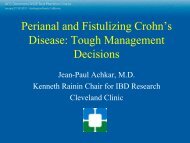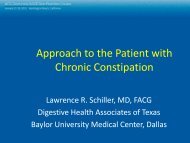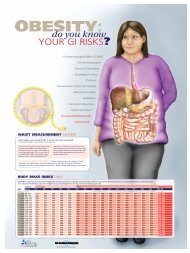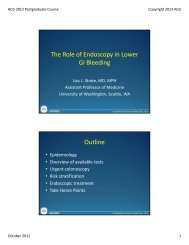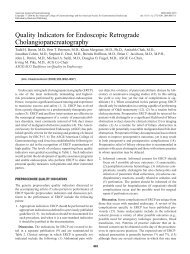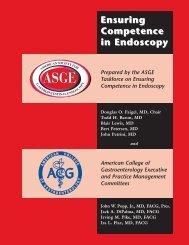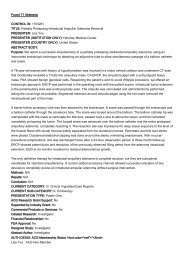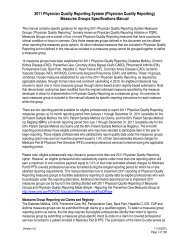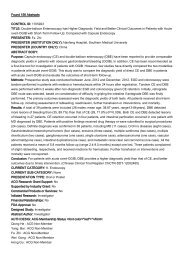Pregnancy
Pregnancy
Pregnancy
Create successful ePaper yourself
Turn your PDF publications into a flip-book with our unique Google optimized e-Paper software.
Heartburn, Nausea, Vomiting During <strong>Pregnancy</strong><br />
................................................................................................................................................................<br />
The prevention of aspiration and aggressive control of<br />
acid secretion are very important in women undergoing<br />
general anesthesia at the time of delivery. Since<br />
the pH of the gastric aspirate is the important factor<br />
determining the severity of chemical pneumonitis, the<br />
thrust of preventing aspiration pneumonia is aimed<br />
at raising the pH of the gastric secretions. Antacids,<br />
H 2<br />
antagonists and omeprazole may be effective in<br />
this acute setting. Promotility drugs, such as metaclopramide<br />
may improve gastric emptying during labor,<br />
help prevent aspiration and are not toxic to the<br />
fetus. 10<br />
Nausea and Vomiting During <strong>Pregnancy</strong><br />
The single most common gastrointestinal complaint<br />
in pregnancy is nausea, occurring in 50% to 90% of<br />
women. Additionally, vomiting is an associated problem<br />
in 25% to 55% of pregnancies. 11 Vomiting is most<br />
common in the first trimester, peaking around 10 to 15<br />
weeks gestation, and subsiding by 20 weeks gestation.<br />
Nausea and/or vomiting is often the initial indication<br />
that a patient is pregnant. Symptoms usually occur in<br />
the early morning (“morning sickness”) and improve<br />
later in the day. Nausea and vomiting during pregnancy<br />
usually is a self-limited problem, disappearing<br />
by the fourth month of pregnancy. The prognosis for<br />
the mother and infant is excellent. There is no correlation<br />
with the complications of pregnancy including<br />
diabetes, hypertension, proteinuria, preeclampsia<br />
and anemia. In addition, there are no increased risks<br />
of low birth weight infants, increased fetal deaths, or<br />
increased congenital malformations. There is speculation<br />
that nausea and vomiting is a good prognostic<br />
sign in pregnancy and that women who experience it<br />
are less likely to have miscarriages or undergo premature<br />
labor. This symptoms complex is more common<br />
in primigravidas, younger women (especially<br />
less than 20 years of age), less educated individuals,<br />
overweight patients and non-smokers. 12<br />
The etiology of nausea and vomiting during pregnancy<br />
is still unknown. Alterations in gastric motility<br />
and gastric tone due to elevated levels of progesterone<br />
have been implicated. Animal studies show that progesterone<br />
is a potent inhibitor of gastric antral contractions.<br />
13 Premenopausal women have slower gastric<br />
emptying rates than men and post-menopausal women<br />
suggesting a hormone acting to inhibit gastric emptying.<br />
14 Only limited studies of gastric function have<br />
been performed in pregnant women. The few gastric<br />
emptying studies, using scintigraphy, have employed<br />
liquid meals and show no delay in emptying in the first<br />
and second trimesters of pregnancy. However, these<br />
studies were not performed with solid meals or when<br />
the patients were nauseated. Animal studies show that<br />
the there is a delay in gastric emptying during the third<br />
trimester of pregnancy. This delayed emptying persists<br />
in the immediate post-partum period but returns<br />
to normal by four days after delivery, suggesting that<br />
this pregnancy-induced gastroparesis is from gastric<br />
motor dysfunction and not secondary to the effects of<br />
an enlarged uterus. More recently, studies using cutaneous<br />
EGG have found an increased prevalence of<br />
gastric dysrhythmias such as bradygastria and tachygastria,<br />
in patients with nausea. 15 These gastric dysrhythmias<br />
correlated with nausea during pregnancy<br />
and resolve during the post-partum period.<br />
Animal studies show that<br />
pregnancy delays small<br />
bowel transit and slows the<br />
migrating motor complex.<br />
Another contributing factor to nausea and vomiting<br />
may be delayed small bowel transit. Animal studies<br />
show that pregnancy delays small bowel transit and<br />
slows the migrating motor complex. Using the lactulose<br />
breath test, studies in women during the third<br />
trimester of pregnancy have confirmed delayed small<br />
bowel transit which reverted to normal after completion<br />
of the pregnancy. 16<br />
Psychological factors may also contribute to nausea<br />
and vomiting during pregnancy. Several studies have<br />
shown that these symptoms are more common in<br />
...................................................................................................................................................................................<br />
21



